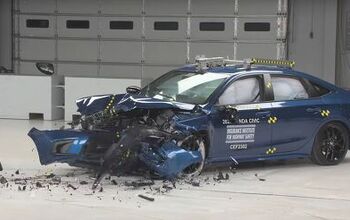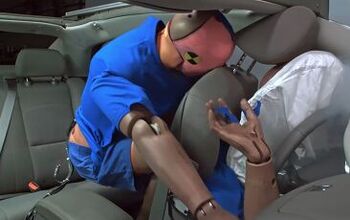IIHS Grouses About Passenger Safety in Rear Seats

The crash test dummies at the Insurance Institute for Highway Safety (IIHS) have been doing great work in ratcheting up the difficulty of their impact examinations, often requiring automakers to return to their drawing boards in search of the elusive Top Safety Pick+ designation. Now, the group is increasingly casting an eye toward how backseat passengers fare in a wreck.
According to a study released yesterday by the IIHS, several popular SUVs in the midsize category offer inadequate front crash protection for folks perched in rear seats. These findings were uncovered after the group tweaked their longstanding moderate overlap front crash test by installing a second dummy in the seat behind the driver. Although the test still includes a driver dummy, the IIHS is also now taking notice of rear passenger protection, making that metric a key differentiator of vehicles in this test.
“All these vehicles provide excellent protection for the driver,” said IIHS President David Harkey, “but only a handful extend that level of safety to the back seat.”
Of a baker’s dozen midsize SUVs tested, only a quartet - Ford Explorer, Ford Mustang Mach-E, Subaru Ascent, and Tesla Model Y - earn Good ratings.
A trio of others - Chevy Traverse, Toyota Highlander, and Volkswagen Atlas - scored a Marginal ranking while six more - Honda Pilot, Hyundai Palisade, Jeep Grand Cherokee, Jeep Wrangler 4-door, Mazda CX-9, and Nissan Murano - were rated Poor.
At issue? Measurements recorded by sensors in the second-row dummy, which is sized like a typical 12-year-old youngster, must not indicate an excessive risk of injury to the head, neck, chest, abdomen, or thigh. Video footage and greasepaint applied to the dummy’s head needs to confirm the restraints prevented its head from hitting the vehicle interior or coming too close to the front seatback, while an eye is kept on the dummy’s risk of “submarining,” which refers to sliding forward beneath the seat belt in a crash. I’ve learned a new word today.
In vehicles rated Poor, sensors indicated a high risk of head or neck injuries to the backseat passenger in all but the Wrangler. That model, lacking a side curtain airbag in the rear, was deemed to pose a significant risk for those injuries. In that Jeep, the lap belt also moved from its ideal position, from the pelvis to the abdomen.
As for these rigs in terms of the moderate overlap test’s original criteria for front seat occupants, there were some odd findings. In the Traverse, the driver dummy’s head hit the steering wheel hard through the airbag, which is a scary notion. And terrifyingly, according to the IIHS report, the driver’s side airbag did not deploy at all in the Wrangler.
[Image: IIHS]
Become a TTAC insider. Get the latest news, features, TTAC takes, and everything else that gets to the truth about cars first by subscribing to our newsletter.

Matthew buys, sells, fixes, & races cars. As a human index of auto & auction knowledge, he is fond of making money and offering loud opinions.
More by Matthew Guy
Latest Car Reviews
Read moreLatest Product Reviews
Read moreRecent Comments
- SCE to AUX 08 Rabbit (college car, 128k miles): Everything is expensive and difficult to repair. Bought it several years ago as a favor to a friend leaving the country. I outsourced the clutch ($1200), but I did all other work. Ignition switch, all calipers, pads, rotors, A/C compressor, blower fan, cooling fan, plugs and coils, belts and tensioners, 3 flat tires (nails), and on and on.19 Ioniq EV (66k miles): 12V battery, wipers, 1 set of tires, cabin air filter, new pads and rotors at 15k miles since the factory ones wore funny, 1 qt of reduction gear oil. Insurance is cheap. It costs me nearly nothing to drive it.22 Santa Fe (22k miles): Nothing yet, except oil changes. I dread having to buy tires.
- AZFelix 2015 Sonata Limited72k when purchased, 176k miles currentlyI perform all maintenance and repairs except for alignment, tire mounting, tire patching, and glass work (tint and passenger left due to rock hit). Most parts purchased through rockauto.com.Maintenance and repairs during three years of ownership:Front rotors and all brake pads upgraded shortly after purchase.Preparing for 17th oil change (full synthetic plus filter c.$50), one PCV valve.Timing & accessory belts, belt tensioner.Coolant full flush and change.Fibrous plastic material engine under tray replaced by aftermarket solid plastic piece $110.One set of tires (c.$500 +installation) plus two replacements and a number of patches due to nails, etc. Second set coming soon.Hood struts $30.Front struts, rear shocks, plus sway bar links, front ball joints, tie rod ends, right CV axle (large rock on freeway damaged it and I took the opportunity to redo the rest of items on this list).Battery c.$260.Two sets of spark plugs @ $50/set.Three sets of cabin and engine filters.Valve cover gasket (next week).Averages out to c.$1400 per year for the past three years. Minor driver seat bolster wear, front rock chips, and assorted dents & dings but otherwise looks and drives very well.
- 3-On-The-Tree 2014 Ford F150 Ecoboost 3.5L. By 80,000mi I had to have the rear main oil seal replaced twice. Driver side turbo leaking had to have all hoses replaced. Passenger side turbo had to be completely replaced. Engine timing chain front cover leak had to be replaced. Transmission front pump leak had to be removed and replaced. Ford renewed my faith in Extended warranty’s because luckily I had one and used it to the fullest. Sold that truck on caravan and got me a 2021 Tundra Crewmax 4x4. Not a fan of turbos and I will never own a Ford again much less cars with turbos to include newer Toyotas. And I’m a Toyota guy.
- Duke Woolworth Weight 4800# as I recall.
- Kwik_Shift_Pro4X '19 Nissan Frontier @78000 miles has been oil changes ( eng/ diffs/ tranny/ transfer). Still on original brakes and second set of tires.



































Comments
Join the conversation
I wonder how long it will take them to come up with the idea of putting a dummy in the third row.
This company arbitrarily designs new tests to make sure they can whine about something.